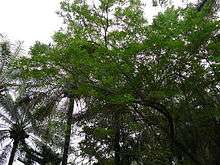Gliricidia
| Gliricidia | |
|---|---|
 | |
| Gliricidia sepium | |
| Scientific classification | |
| Kingdom: | Plantae |
| (unranked): | Angiosperms |
| (unranked): | Eudicots |
| (unranked): | Rosids |
| Order: | Fabales |
| Family: | Fabaceae |
| Subfamily: | Faboideae |
| Tribe: | Robinieae |
| Genus: | Gliricidia Kunth |
| Species[1] | |
| |
| Synonyms[1][2] | |
| |
Gliricidia is a genus of flowering plants in the legume family, Fabaceae. It belongs to the sub family Faboideae. It is a small, deciduous, ornamental tree. The tree is leafless when in flower and bears fruits during April and May in India and countries with same climate. The small flowers (barely 2 cm long) are pale pink and they are borne in dense clusters on bare twigs. Flowers fade to white or a faint purple with age. The flowers attract a lot of bees and some lycaenid butterflies—particularly the Peablue Lampides boeticus and other native birds.
The species Gliricidia sepium is cultivated and used for a variety of purposes in tropical regions.
References
- 1 2 Lavin M, Wojciechowski MF, Gasson P, Hughes C, Wheeler E (2003). "Phylogeny of Robinioid Legumes (Fabaceae) Revisited: Coursetia and Gliricidia Recircumscribed, and a Biogeographical Appraisal of the Caribbean Endemics" (PDF). Systematic Botany. 28 (2): 387–409.
- ↑ Kew
| Wikimedia Commons has media related to Gliricidia. |
| Wikispecies has information related to Gliricidia |
This article is issued from
Wikipedia.
The text is licensed under Creative Commons - Attribution - Sharealike.
Additional terms may apply for the media files.